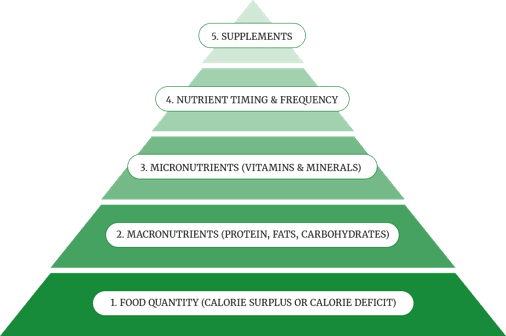How Diets Work, And How To Fix One That Is Not Working

I often get asked “Do you do Paleo, intermittent fasting, keto, or the ‘insert any other well-known diet’ coach?” My response: All of them and none of them!
I’m focused on personalization for me and you can be focused on personalization for you, also. Nutrition is highly individual and everyday more and more research is being published in support of this! The ability to personalize your dietary habits, foods and more will provide you with true freedom while achieving your goals and enjoying your eating habits at the same time.
Is there really one ‘right way’ to eat for all people, considering our diverse ethnic heritages, modified DNA and changing environmental factors?
Surely not, which is why you see people having success with their body composition, health, and physical fitness while doing a myriad of different eating styles. On the other hand people are still struggling with their body composition, and poor health markers and fitness levels while following similar advice that is intended for one subset of the population (i.e. ketogenic diet for those that thrive from a low-carbohydrate intake). Why try to do something that works for someone else, when you can do what works for you?
Personal nutrition is not just about suggesting a particular diet protocol you have read about, or the current trend, but needs the consideration of:
- Ethnic origin
- DNA
- Current environment
- Time of year
- Location
- Stress levels
- Toxicity status
- Lifestyle
- Likes/dislikes
- Personal preferences
Current Philosophy
Here is a test you can try on just about anyone. Ask them to identify themselves as an ‘eating type’.
The typical answers you will get are Paleo, vegan, vegetarian, intermittent faster, carnivore, omnivore or even the ‘eat everything’ type.
Eating is a tribal activity, and we are always seeking to belong to something or a specific group. When we belong to a type or a group, we become defensive about them and feel that it is the best system, therefore failing to see the bigger picture.
With regards to nutrition, that bigger picture is personalization. This is my problem with many of the current ‘popular diets’ - many of them do not account for the individual needs of the user.
“So Why Do They Work?”
THEY HELP ACHIEVE A CALORIC DEFICIT/SURPLUS
Firstly, although it is not “written on the box” many of the themed diets (e.g. Paleo, low-carb, keto) work because they are roundabout methods of achieving a calorie deficit. If you cut out processed foods (Paleo diet) from your diet, chances are fiber intake will increase and refined carbohydrate intake will decrease – resulting in reduced hunger and less food intake.
This ‘calorie in, calorie out’ equation is generally regarded as the main principle at play in whether you gain weight or lose it (Those who don’t regard as that are trying to make a quick buck!).
Eat more than you need, gain weight (both muscle and fat, regardless of macronutrient ratio), or eat less than you expend, and you will lose weight (primarily fat, but some muscle too).
It’s impossible to override or lose weight/gain muscle through some other mechanism. There are however, secondary factors that can help you achieve a deficit/surplus that are sometimes mistakenly adopted as an alternative e.g. low-carbohydrate diets. When we want to gain weight, we must eat more than we need to supply the body with sufficient energy and nutrients in order for it to be able to lay down new muscle tissue.
You see, even if you cut out carbohydrates but still consume more energy than you burn in a day, your body can synthesize fat cells (adipose) from carbohydrates through a process that has a very scary name – De Novo Lipogenesis (Think liipo – fat, Genensis – creation).
THEY IMPROVE FOOD TYPES (MACRONUTRIENT BALANCE)
Some of the modern dietary approaches take a food-first approach and focus on eliminating specific foods or food groups completely (e.g. Ketogenic diet). Some take an additive approach and instead, have you add nutrient-dense wholefoods (e.g. Paleo diet)
This ensures the person is then eating a high-nutrient diet which in turn makes them not only see visual changes, but notice improved health markers and performance in sport/exercise too! This usually means the person has more energy to exercise and will conduct it more often.
In addition, this also:
- Helps them control their calorie intake (without counting calories)
- Provides longer periods of satiation (fullness) between meals
- Reduces overeating
- Provides higher total essential nutrients in diet
THEY IMPROVE THE MICRONUTRIENT INTAKE (VITAMINS AND MINERALS)
A good diet highlights the importance of in taking adequate micronutrients daily, including fiber and water. Many of the modern protocols do just this, placing emphasis on whole, single-ingredient foods. This ensures sufficient amounts of fruit and vegetables in the diet, which are also the cornerstones to keeping ample amounts of micronutrients in the diet.
THEY FOCUS ON FOOD TIMING AND MEAL FREQUENCY
Many of the modern nutrition protocols educate their users on the importance of nutrient timing, that is, about when certain nutrients can be consumed to improve the efficacy of the diet (e.g. Intermittent fasting) and performance adaptations (e.g. post-workout protein intake).
For example, everybody has heard of the ‘anabolic window’. It’s that 1-2 hour period post-training when our body is sensitized to absorb and utilize certain nutrients e.g. carbohydrates (depending on the training) and protein.
New studies have shown however, that if daily protein intake isn’t sufficient, the timing of your post-workout shake won’t have much of an effect. However, when daily intake is achieved, it is optimal to provide your muscle with essential amino acids to repair the damage done in the workout!
Many modern protocols will also set guidelines on eating frequency to match their other recommendations, thus further enhancing user compliance.
SUPPLEMENTS
Many modern protocols will also introduce some supplementation in the process of changing someone’s nutritional habits and routine.
We do know there are a number of supplements that have been field tested and research proven to show they work, but we must always consider the following two things:
- Quality and Quantity – does the quality of the supplement meet recommended manufactory standards and compliances? Have the key ingredients been significantly researched to prove results - and at the same dosages - prescribed in the supplement? If any of these factors are not met, you should avoid the supplement and find a better available alternative.
- Is it safe – are all the ingredients in the supplement approved by the World Anti Doping Association (WADA)? If not, you should avoid the supplement and look for an alternative that is. They are not worth the risk. However, this only applies if you are an athlete. Many supplements will be safe and approved by the Food and Drug Administration (FDA) but not WADA. Athletes that are subject to testing can only consume those approved by WADA, while everyday adults don’t need to. But, with a few exceptions, you should stick to the WADA-approved supplements as they have been subject to rigorous testing and are deemed safe.
These two factors must always be considered when suggesting supplements, and even more so when understanding some of the supplements attached to modern nutrition protocols.
The previous information can be summarized into the following pyramid, with the base being the foundation- the most important- and working upward to the top level.
Many modern nutrition protocols achieve level 1, thus being able to manipulate the user’s body composition. Others will incorporate levels 2-5, while adhering to all 5 levels always brings the best results.
These are the fundamental components to any plan. When we read the success stories and testimonials from those following a modern nutrition protocol such as Paleo, intermittent fasting etc., we must understand that this is a result of the manipulation of 1 or more of these categories.

Many of the modern nutrition protocols or ‘diets’ use a variety of guidelines, restrictions or techniques to achieve this. As a result, although they are all doing the same thing (or have a very similar objective) they will feel very different when following them.
Redefining Nutrition
When seeking to match the right nutrition protocol to someone, it must be based upon their initial goals as well as their responses over time to these protocols.
Many individuals are solely focused on achieving progress as a change in the scales or the fitting of their clothes, but this is what is also holding them back the most.
Therefore, I set myself criteria to always work from when prescribing a nutrition program or dietary approach to my clients. Help them to see the other important markers of progress including energy levels, well-being, sleep, relationship with food and others like this.
From my experience this brings much better results and helps create a successful long-term environment for the achievement and maintenance of a healthy, balanced diet long into the future.
This is because we are moving away from a sole focus on how the person is looking to also considering their health and well-being.
Therefore, whether we are designing or simply following nutrition programs that may or may not include some of the modern nutrition protocols, we must ensure that we also take into consideration and respect how we respond emotionally as well as physically to these.
A nutrition plan that successfully ticks all your boxes will not only bring the best results but will also ensure it has the potential to become a long-term change in the process.
IMPROVED BODY COMPOSITION
This is what most people instantly want, be it fat loss or to generally look good naked. If body composition is improving without the expense of the other two components and it is maintainable, you are successful controlling energy balance.
IMPROVED HEALTH
Many people don’t realize their health is a key driving factor to how their body looks. It is important for us to understand the benefits of following good nutrition that will not only improve body composition but overall health too. We should see better energy, sleep, mood, confidence and a generally improved bill of health.
IMPROVED PERFORMANCE
We should also be aiming for improved performance markers from our nutrition. Whether in sports, hobbies or general day time activities, they should be able to perform these to their maximum ability.
It’s important to always consider and monitor (based on feedback) these three factors, especially when it comes to program design and when considering the possible introduction of various protocols and techniques.
This process will also help you assess any new protocols that you may hear or learn about. Before adopting these, always think: how will this make them feel, look and perform?
A drop or reduction in any of these three factors is a tell-tale sign that the current nutrition recommendations are not quite right for the person.
Summary
You will know you have found the perfect diet when you can tick off all three of these factors.
In order to find the perfect diet, we must match the right nutritional protocols and guidelines that also respect the body’s composition and health pyramid.
-------------------------------
Could you use some help getting an eating plan together that works for you and also gets you the results you want? Contact us at 919-724-4600 or cary@workoutanytime.com to schedule a Free Success Session. We can help you work toward a plan that works for you.
We Stand By Our Values
We offer affordable fitness with high-quality equipment whenever you want it. Fitness that fits your life means there’s no excuse, just results.

Attitude
We drive a positive culture of confidence and enthusiasm by doing the right thing for all our members, partners, and staff.

Care
We provide our members, partners and staff with an environment that is welcoming and respectful of each individual.

Excellence
We are committed to the success of our members and partners through the expertise and dedication of our team.




